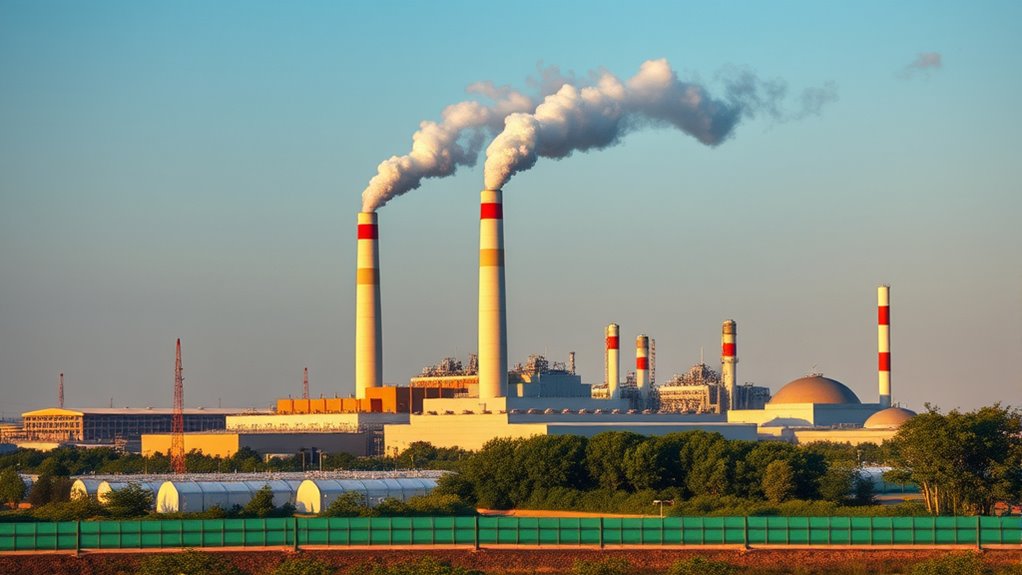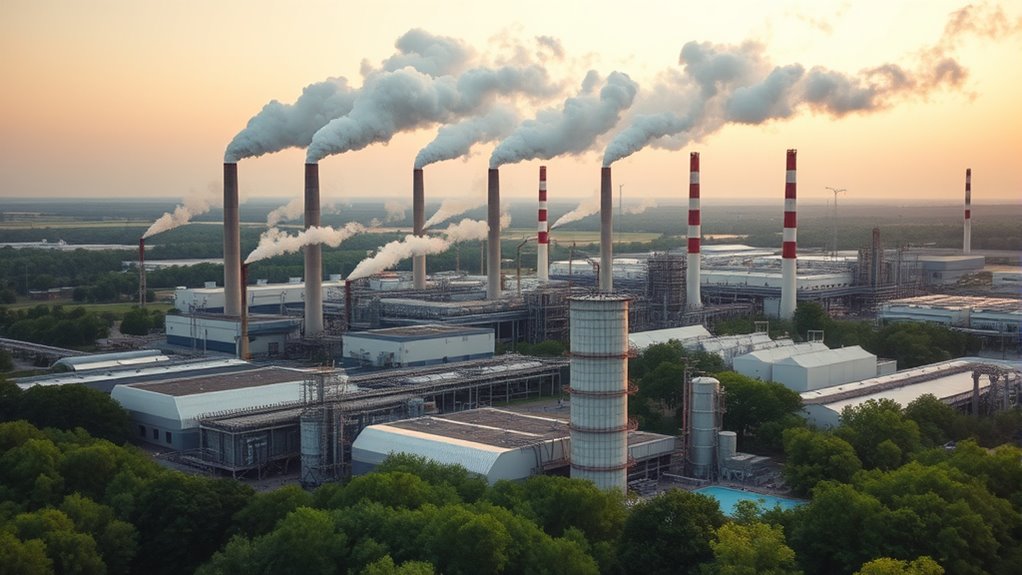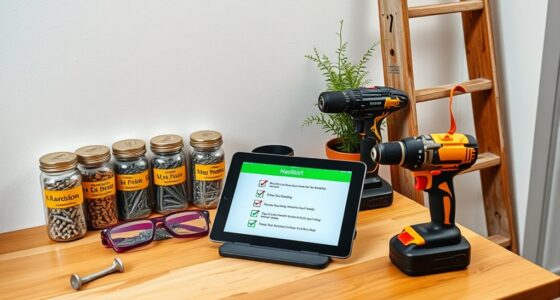Source control involves actively preventing pollutants from escaping into the environment right at their source. You can achieve this by using technologies like scrubbers, filters, and process modifications that trap or reduce emissions before they spread. By focusing on the origin, you cut down on overall pollution, guarantee compliance with regulations, and protect public health. Staying vigilant with regular maintenance is key. Keep exploring to discover more ways to effectively eliminate pollutants at their origin.
Key Takeaways
- Source control prevents pollutants from entering the environment by managing emissions at their source.
- Technologies like scrubbers, filters, and process modifications reduce airborne pollutants effectively.
- Implementing source control measures ensures regulatory compliance and enhances public health protection.
- Regular maintenance and monitoring of equipment sustain optimal pollution prevention performance.
- Prioritizing source control contributes to a cleaner environment and reduces costly cleanup efforts later.

Have you ever wondered how software teams prevent chaos in their codebases? The same principle applies to controlling industrial emissions and pollution prevention. Instead of letting pollutants escape and cause environmental chaos, proactive measures are taken right at the source. When it comes to industrial emissions, source control becomes essential. It’s about identifying and managing pollutants before they get a chance to contaminate the air, water, or land. Think of it as setting up barriers and filters at the origin, stopping harmful substances from spreading outward. This approach not only minimizes environmental impact but also reduces the need for costly cleanup later on.
In practice, source control involves implementing technology and processes that capture or eliminate pollutants during production. For example, industries use scrubbers, filters, and catalytic converters to trap airborne pollutants before they are released into the atmosphere. These tools act like gatekeepers, intercepting harmful emissions such as sulfur dioxide, nitrogen oxides, and particulate matter. By focusing efforts on pollution prevention at the source, companies can considerably cut down their overall emissions, complying with environmental regulations and protecting public health. It’s a proactive stance—preventing pollution rather than reacting to it afterward—which translates into cleaner air and a healthier environment.
Moreover, source control measures often include process modifications that inherently reduce emissions. This could mean upgrading machinery to more efficient models, optimizing fuel use, or adopting cleaner production techniques. These steps not only prevent pollution but can also boost operational efficiency, saving money in the long run. It’s about integrating pollution prevention into the core of industrial processes. When you control pollutants at their origin, you avoid the accumulation of harmful substances downstream, simplifying environmental management and reducing liabilities.
Effective source control also involves continuous monitoring and maintenance. You need to regularly check equipment like filters and scrubbers, ensuring they operate at peak efficiency. If a device fails or becomes less effective, pollutants could bypass safeguards and escape into the environment. Consequently, ongoing oversight and prompt repairs are crucial. This vigilant approach helps sustain pollution prevention efforts and prevents accidental releases that could cause environmental harm.
In essence, source control is about taking responsibility from the very beginning. It’s the most direct and effective method to combat industrial pollution, emphasizing pollution prevention over cleanup. By managing pollutants at their origin, you not only comply with regulations but also contribute to a healthier, cleaner planet. It’s a proactive strategy that makes a real difference—one that requires commitment, innovation, and constant vigilance to ensure that pollutants never get the chance to cause chaos downstream. Incorporating Unique and Wicked Planters into your workspace or environment can also serve as a reminder of the importance of thoughtful planning and innovation in all aspects of sustainability.
Frequently Asked Questions
How Cost-Effective Is Source Control Compared to Other Pollution Reduction Methods?
Source control is often more cost-effective than other pollution reduction methods because it involves a straightforward cost analysis that targets pollutants at their origin, preventing cleanup later. You can realize significant economic benefits by investing upfront in cleaner technologies and process modifications. These measures reduce long-term expenses, minimize environmental damage, and promote sustainable practices, making source control a smart, economical choice for reducing pollution efficiently and effectively.
What Industries Benefit Most From Implementing Source Control Strategies?
You benefit most from implementing source control strategies if you’re in industries with high industrial emissions and wastewater management needs. These industries, such as manufacturing, chemical production, and power generation, can drastically reduce pollutants at their origin. By controlling emissions and managing wastewater effectively, you improve environmental health, comply with regulations, and often lower long-term costs. Focusing on these areas maximizes your pollution reduction impact and promotes sustainable operations.
Are There Any Legal Regulations Governing Source Control Practices?
Yes, you must follow legal regulations governing source control practices to guarantee legal compliance. Regulatory enforcement agencies, like the EPA, set standards and monitor industries to prevent pollution at its source. If you neglect these laws, you risk fines or penalties. Staying informed about current regulations helps you implement effective source control measures, protecting both your operations and the environment, and avoiding legal issues.
How Do Source Control Techniques Vary Between Air and Water Pollution?
You’ll notice that source control techniques differ between air and water pollution in industrial applications. For air pollution, you might use scrubbers, filters, or catalytic converters to capture pollutants before release, helping you meet regulatory compliance. In water pollution, you typically implement treatment systems like sedimentation or filtration at discharge points. Understanding these differences allows you to effectively control pollutants at their origin, ensuring environmental safety and compliance with regulations.
What Are the Latest Innovations in Source Control Technology?
You won’t believe the groundbreaking tech transforming pollution control! With innovative filtration systems that seem to defy limits, pollutants are snatched out before they escape. Plus, real-time monitoring sensors provide instant data, letting you tackle issues immediately. These advancements mean cleaner air and water, revolutionizing how we prevent pollution at its source. It’s like having a superpower to stop pollutants dead in their tracks—making our environment safer than ever!
Conclusion
Just as Prometheus stole fire to bring light, you can take action at the source to prevent pollution from spreading. By controlling pollutants at their origin, you become a guardian of the environment, ensuring nature’s gift remains pure. Remember, every small effort you make today echoes like a ripple through eternity. So, take responsibility now—because even the mightiest oak begins as a tiny seed, and your choices can shape a cleaner, healthier world for generations to come.








